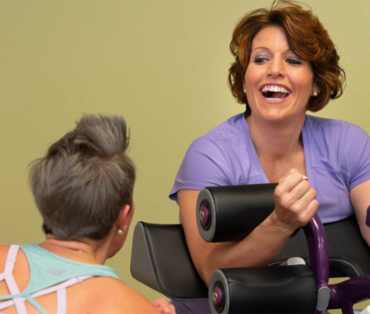Get Strong and Help Fight Heart Disease with Curves
Want a strong heart? One that’s able to power you through a long, healthy, and happy life? Make a date—several dates—with Curves. Strength training has a remarkable ability to tackle four key risk factors for heart disease: obesity, high blood pressure, high cholesterol, and insulin resistance. And, when done in a circuit like Curves, you also get a heart-pumping, calorie-burning cardio workout. Check it out.
Strength training torches fat and helps you drop pounds
Muscle is active even when you’re not, meaning that it burns calories while you’re watching Downton Abbey. Add more muscle; burn more calories, including fat calories. Studies have shown that a 3-pound gain in lean muscle may result in roughly a 4-pound (1.8kg) loss in fat1. More significantly, research shows that with resistance training2, visceral fat in the abdominal area–a big risk factor for heart disease–is reduced.
Of course, resistance training itself consumes calories, but it also creates an after-burn effect. Once you’ve stopped exercising, your body burns calories as it restores all systems back to normal. Next begins the process of repairing micro-damage and rebuilding muscle, which boosts calorie-burn for three days post-workout, says Wayne Wescott, PhD, professor of exercise science at Quincy College.
Strength training helps lower resting blood pressure
Research shows that regular resistance workouts help lower blood pressure—either systolic (the upper number, which measures the pressure in your blood vessels when your heart contracts), diastolic (the bottom number, which measures pressure between heart beats) or both. A 2009 study1 involving 1600 participants, age 21 to 80, found that combined strength and aerobic exercise performed three times a week significantly reduced both systolic and diastolic blood pressure.
Strength training may help improve your cholesterol profile
Study results are mixed regarding the effect of resistance training on cholesterol. The American College of Sports Medicine3 reports that though the effect on total cholesterol is minimal, HDL (good cholesterol) levels increase with regular strength workouts. Aerobic exercise appears to produce greater improvements in cholesterol, and remember, at Curves you get both a strength and cardio workout in one.
Regular exercise also improves your ratio of good LDLs to bad LDLs. Yes, you read that right. Not all LDL molecules are bad: some are small, and they are particularly damaging, others are large and less harmful. Studies show that exercise increases large LDL molecules while decreasing the small, harmful ones.
Strength training enhances insulin response
Diabetes and prediabetes are significant risk factors for heart disease, and regular resistance training in combination with weight loss can help you manage diabetes and even reverse prediabetes. Muscle is your body’s number one consumer of blood sugar, points out Timothy Church, MD, MD, MPH, PhD, professor of preventative medicine at Pennington Biomedical Research Center at Louisiana State University. Strength-training builds a bigger consumer.
“The immediate effect of exercise is to help control blood sugar for 24 to 48 hours post-workout as muscle cells pull glucose from your blood to replenish spent stores,” says Church. As you continue to exercise regularly, your muscle cells become more sensitive to insulin, meaning less insulin is required to usher glucose into those cells. In addition, research has found that during exercise, your muscles take glucose out of your blood through a second pathway that does not require insulin. Add these two effects together, and if you are taking insulin or one of the medicines that promote insulin secretion, regular exercise4 may lead to a reduction in your medication.
The Curves Circuit produces some pretty powerful cardiovascular results, so work your muscle for the most important muscle in your body—your heart. For more information on the benefits of the Curves Circuit, visit ‘Why Curves’. Not yet a Curves member? Find your local Curves women’s gym and sign up today!







